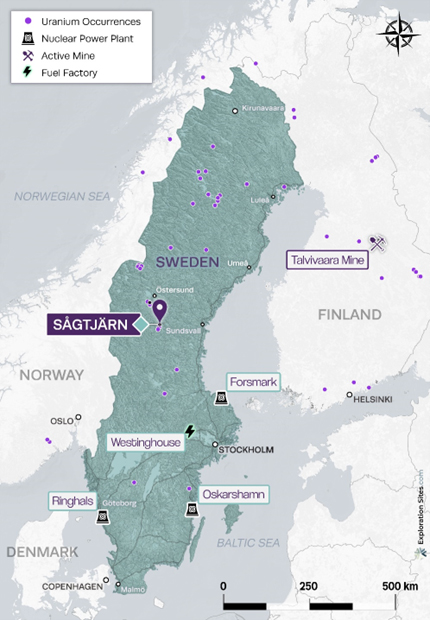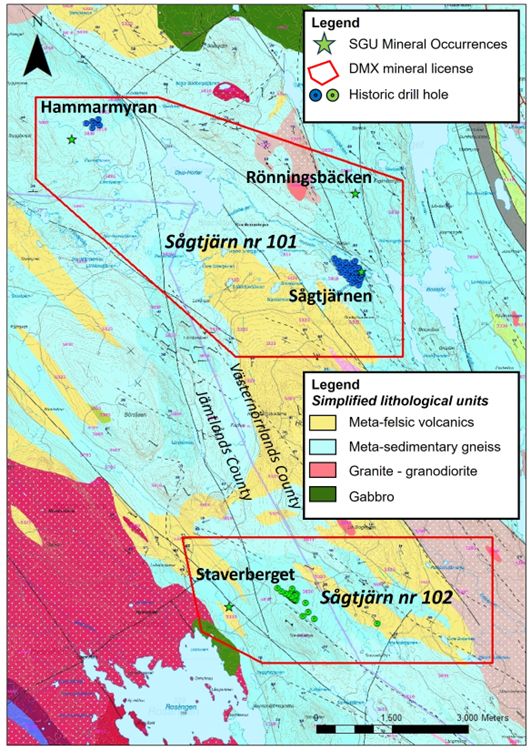Overview
In May 2023, District Metals received approval from the Bergsstaten (Mining Inspectorate) for the Sågtjärn nr 101 and 102 mineral license applications to explore for copper, zinc, lead silver, gold, molybdenum and cobalt over a 4,068 hectare (ha) area located in the Jämtland and Västernorrland Counties in central Sweden (Figure 1 and 2).
Sågtjärn Property Highlights:
- Mineral license Sågtjärn nr 101 contains the Sågtjärn Uranium Deposit. A Technical Report prepared for Continental Precious Minerals Inc. by Telluride & Associates dated September 20, 2005 on the Sågtjärn Deposit calculated an historical mineral resource estimate for U3O8 of:
- Historical Inferred Mineral Estimate: 756,000 tonnes at a grade of 0.068% U3O8 containing 1,137,585 lbs of U3O8 using a 200 ppm uranium cut off1.
The above mineral resource estimate is considered to be an “historical estimate” under National Instrument 43-101 – Standards of Disclosure for Mineral Projects (“NI 43-101”). A Qualified Person has not done sufficient work to classify the historical estimate as a current mineral resource, and the Company is not treating this historical estimates as a current Mineral Resource. The Company would need to conduct an exploration program, including twinning of historical drill holes in order to verify the Sågtjärn Deposit historical estimate as a current mineral resource.
- The Sågtjärn Deposit remains open in all directions, and contains the following drill result highlights:
- Hole SGT-77-007 intersected 8.7 m at 0.13% U3O8 from 60.3 to 69.0 m.
- Hole SGT-77-011 intersected 7.0 m at 0.18% U3O8 from 86.0 to 93.0 m.
- Hole SGT-79-011 intersected 5.2 m at 0.13% U3O8 from 132.6 to 137.8 m.
- Hole SGT-80-001 intersected 4.6 m at 0.13% U3O8 from 146.5 to 151.1 m.
- Mineral license Sågtjärn nr 102 contains the Staverberget Mineral Occurrence, which is highlighted by:
- Historical boulders that returned assays from background levels up to 1.3% Cu, 1.8% Mo and 1.3 g/t Au.
- Limited historical drilling intersected 0.8 m at 1.46% U3O8, 1.26% Mo, 0.25% Pb, 0.2% Zn, 0.2% Cu, and 10 g/t Ag.
Figure 1: Sågtjärn Property Location
Geological Setting
The regional geology where Sågtjärn is situated is part of the Sveckokarelian Province of the Precambrian Baltic Shield which runs from south of Stockholm to the far north of Sweden where Lapponian - Jatulian rocks of Archaean age occur. The Sveckokarelian province is bounded to the west by thrust nappes of sedimentary and volcanic rocks of Caledonian age and its eastern boundary lies across the Baltic Sea in Finland1.
The basement of the Svecokarelian Province developed before and in conjunction with the Svecokarelian orogenesis that occurred ~1,800 to 1,850 million years ago. The basement is dominated by plutonic rocks, usually granitoids, that are ~1,600 to 1,900 million years old, though successive generations of ‘post-orogenic’ or younger granites continued to be intruded until ~1,500 Mya and are found throughout the entire province. The earliest granitoids are believed to be of mantle origin, and have suffered high-grade metamorphism, anatexis and major deformation, whereas the younger granitoids believed to be of crustal origin, are largely unaffected2.
Dolerites are common intrusives occurring as dyke swarms of marking crustal sutures and major fracture zones throughout the area. They are aged ~900 to 1,500 million years ago1.
The supracrustal rocks of the Sveckokarelian Province are composed of Svecofennian
terrestrial meta-sediments and metavolcanics dating from ~1,950 to 1,800 million years old. Basal meta-greywackes and meta-argillites predominate in the Svecofennian sedimentary rocks, with rare overlying meta-arenites, meta-arkoses and marbles. The stratigraphically higher metavolcanics are predominantly silicic to intermediate in composition e.g. metarhyolites; while basic metavolcanics occur towards the southeastern part of the province. In many cases, regional metamorphism was of such a high grade that the supracrustals have partly migmatised into gneisses.
Tectonism has commonly caused the supracrustals to become tightly folded, often with
multiple generations of folding. Major regional fracture systems, generally trending north to northeastwards, developed during the major D2 deformational event some ~1,820 to 1,870 million years ago3.
The geologic sequence at Sågtjärn is composed of Proterozoic sedimentary “gneisses” which have undergone upper amphibolite facies metamorphism. The upper, biotite-rich “argillaceous” gneiss overlies a sillimanite bearing “arenitic” gneiss. Part of the meta-argillite has been skarnified, with the introduction of iron and minor scheelite mineralisation. Other rock types include remnants of basic dykes, granitic dykes and two types of pegmatoid, one of which hosts the mineralisation. The unmineralised granitic pegmatoid occupies over 20% of the rock volume at Sågtjärn4.
Figure 2: Sågtjärn Property Mineral Licenses
Sågtjärn Exploration History
The uranium occurrences on the Sågtjärn Property were discovered during follow-up work of geochemical soil anomalies in 1974 by the Swedish Geological Survey (SGU). Detailed outcrop mapping, boulder hunting and sampling started in 1975 followed by ground geophysical surveys and systematic geochemical sampling.
Drilling commenced in 1977 and was completed in early Spring 1980. Forty-three diamond drill and four percussion holes were drilled during this period giving a total of 6,655 m at the Sågtjärn Uranium Deposit. A preliminary historical mineral resource estimate of 757,145 tonnes at a grade of 0.087% U3O8 containing 1,464,883 lbs of U3O8. This preliminary historical estimate was based on the profile calculation method using a minimum 2 m width and a 300 ppm uranium cut-off based on XRF analysis4.
This historical mineral resource estimate is based on a 1981 Report by L-O Forsberg and F. Kullman, Swedish Geological Survey. It is considered to be “historical estimates” under National Instrument 43-101 – Standards of Disclosure for Mineral Projects (“NI 43-101”). A Qualified Person has not done sufficient work to classify the historical estimate as a current mineral resource, and the Company is not treating this historical estimate as current Mineral Resource. This preliminary historical mineral resource estimate was revised by Telluride & Associates’ technical report dated September 20, 20051.
The Sågtjärn Uranium Deposit remains open in all directions, especially towards the northwest where historical hole SGT-80-001 intersected 4.6 m at 0.13% U3O8 from 146.5 to 151.1 m. The historical drill cores have not been analyzed for other potentially economic elements of interest.
Multiple companies historically explored the Sågtjärn area for base- and precious metals. This includes the Staverberget area with copper, molybdenum, and gold enriched boulders that assayed from background levels to 1.3% Cu, 1.8% Mo and 1.3 g/t Au hosted by metamorphosed, fine-grained mica-rich sediment-gneiss. Follow-up drilling in 1982 (987 m in 7 drill holes) intersected a 0.8 m mineralized interval with 1.46% U3O8, 1.26% Mo, 0.25% Pb, 0.2% Zn, 0.2% Cu, 10 g/t Ag5.
The last company who held mineral licenses covering the Sågtjärn Property was Continental Precious Minerals from 2005 to 2014 where they drilled one hole (SGT-07-001) in the center of the Sägtjärn Uranium Deposit that returned confirmatory assay results. No modern exploration techniques including geophysics have been applied on the Sågtjärn Property.
Sågtjärn Deposit
The Sågtjärn Uranium Deposit covers an area of approximately 700 by 400 m, which remains open in all directions. The deposit is situated in a broad valley bottom with numerous small lakes and marshes. A small part of the deposit outcrops but most of the area is covered with glacial till to depths of up to 8 m. The deposit is under drilled4.
The wall rock structure is that of an open flat synformal fold structure whose axis dips gently (~10°) towards the northwest. The skarn lies in the meta-argillites, just above the meta-arenite and, based on drill sections, appears to be largely stratiform. The mineralised pegmatoids occur as irregular sheetlike zones crosscutting the gneisses and the skarn. They strike west-northwesterly (N60°W) and generally dip at 40 to 60° towards the southwest that further shallow towards the southwest of the deposit4.
The uranium bearing pegmatoids are usually coarse grained, biotite-rich, quartz-feldspar rocks with minor quantities of chalcopyrite, molybdenite and monazite. Uranium has an affinity for biotite in which it tends to be concentrated. The primary uranium mineral is uraninite, which is commonly interstitially veined with radiogenic lead. Secondary uranium minerals occur within boulders and in outcrops.
Minor quantities of scheelite occur within narrow “low-grade” lenses within the skarn horizon where XRF tungsten analysis from some of the better mineralised portions of the core varies from 11 to 1,890 ppm4.
The Sågtjärn Deposit is under drilled due to the curtailment of the SGU’s uranium exploration program. It is open both along strike and down dip, as well as requiring a number of infill holes to tighten up the historical inferred mineral resource estimate4.
References:
1 Phillips AH, 2005: Revised introductory technical report on eight uranium properties
in Northern Sweden; Telluride & Associates for Continental Precious Minerals Inc;
revised report 20 Sep 2005; SEDAR filing.
2 Lundqvist T., and Bygghammar, B., 1994 “The Swedish PreCambrian” in Geology : National
Atlas of Sweden. Editor Fredén, C.. Royal Swedish Academy of Sciences. First Edition, 208
pgs.
3 Weihed, J.B., 2001 Palaeproterozoic deformation zones in the Skellefte and Arvidsjaur areas,
northern Sweden. In Weihed J., (Editor) Economic geology Research. Vol. 1, 1999-2000.
Uppsala 20001. Sveriges Geologiska Undersökning, C 833, pgs 46 to 68.
4 Forsberg, L-O. and Kullman, F., 1981: Sågtjärnen, Detailed Prospecting and Ore Estimation. Uranrapport 1981-3, Sveriges Geologiska Undersökning, BRAP 81033, p. 73.
5 Persson, G., 1983: Molybdenminerliseringen Steverbergt. Prospekteringsrapport, Sveriges Geologiska Undersökning, BRAP 82601, p. 45.


